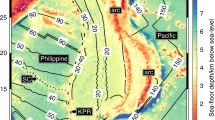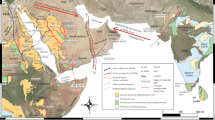Abstract
THE Pacific ocean basin is attributed to a single, continuously active ridge system which is believed still to be active today in the eastern Pacific, although much of the eastern flank of the ridge and parts of the ridge itself have been subducted into a fossil trench along the west coast of North America and active trench regions such as the Aleutian trench and the Peru-Chile trench. One problem with this model is the present activity on the island of Hawaii, which according to the model is sitting in the centre of a stable plate. One explanation is based on Wilson's proposal1 that the linear ridges in the Pacific were formed as the crust moved over a localized “hot spot” in the asthenosphere or upper mantle, but the physical problems involved in creating and maintaining such localized “hot spots” over millions of years have largely gone unanswered. Although a few workers remain sceptical (see ref. 2), acceptance of the theory has been widespread.
This is a preview of subscription content, access via your institution
Access options
Subscribe to this journal
Receive 51 print issues and online access
$199.00 per year
only $3.90 per issue
Buy this article
- Purchase on Springer Link
- Instant access to full article PDF
Prices may be subject to local taxes which are calculated during checkout
Similar content being viewed by others
References
Wilson, J. T., Can. J. Phys., 41, 863 (1963).
Woollard, G. P., Geol. Soc. Amer. Abs., 4, 264 (1972).
Heirtzler, J. R., Dickson, G. O., Harron, E. M., Pitman, W. C., III, and LePichon, X., J. geophys. Res., 73, 2119 (1968).
Hayes, D. E., and Pitman, W. C., III, Geol. Soc. Amer. Mem., 126, 291 (1970).
Fischer, A. G., Heezen, B. C., Boyce, R. E., Bukry, D., Douglas, R. G., Garvison, R. E., Kling, S. A., Krasheninikov, U., Lisitzin, A. P., and Pimm, A. C., Science, N.Y., 168, 1210 (1970).
Scholl, D. W., Creager, J. S., Boyce, R. E., Echols, R. J., Pullman, T. J., Grow, J. A., Keizumi, I., Lee, J. H., Ling, H. Y., Steward, R. J., Supko, P. R., and Worsley, T. R., Geotimes, 16, 12 (1971).
Fisher, R. L., Sclatter, J. G., and McKenzie, Geol. Soc. Amer. Bull., 82, 553 (1971).
Ozima, Minoru, Kaneoka, Ichiro, and Aramaki, Sigeo, Earth planet. Sci. Lett., 8, 237 (1970).
Clague, David A., and Dalrymple, G. Brent Earth planet. Sci. Lett., 17, 411 (1971).
Malahoff, A., and Handschumacher, D. W., J. geophys. Res., 76, 6265 (1971).
Author information
Authors and Affiliations
Rights and permissions
About this article
Cite this article
HANDSCHUMACHER, D. Formation of the Emperor Seamount Chain. Nature 244, 150–152 (1973). https://doi.org/10.1038/244150a0
Received:
Revised:
Issue Date:
DOI: https://doi.org/10.1038/244150a0
This article is cited by
-
Seamount age prediction machine learning model based on multiple geophysical observables: methods and applications in the Pacific Ocean
Marine Geophysical Research (2021)
-
Glutamate dehydrogenase of the germinating triticale seeds: gene expression, activity distribution and kinetic characteristics
Acta Physiologiae Plantarum (2011)
-
Glutamine synthetase and glutamate dehydrogenase in cadmium-stressed triticale seedlings
Acta Physiologiae Plantarum (2006)
-
Effect of selected compounds on the activity of glutamate dehydrogenase from triticale roots
Acta Physiologiae Plantarum (2002)
-
Purification and characteristics of glutamate dehydrogenase (GDH) from triticale roots
Acta Physiologiae Plantarum (2001)
Comments
By submitting a comment you agree to abide by our Terms and Community Guidelines. If you find something abusive or that does not comply with our terms or guidelines please flag it as inappropriate.



